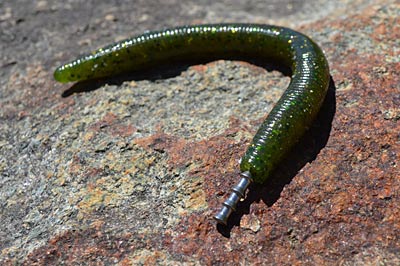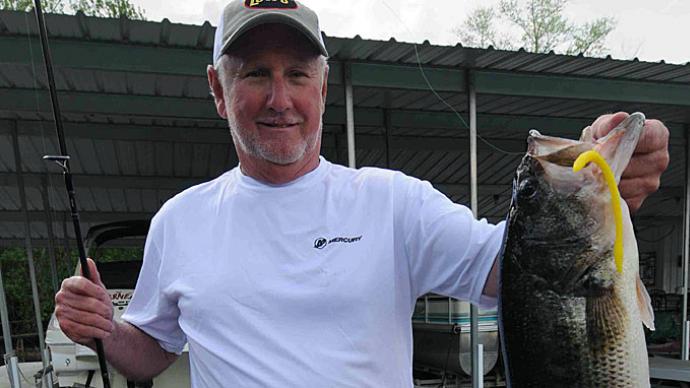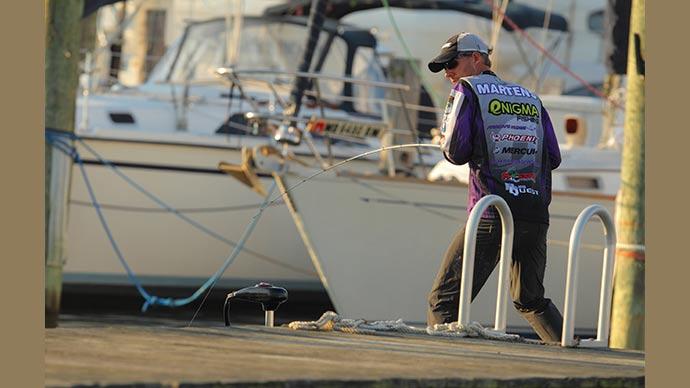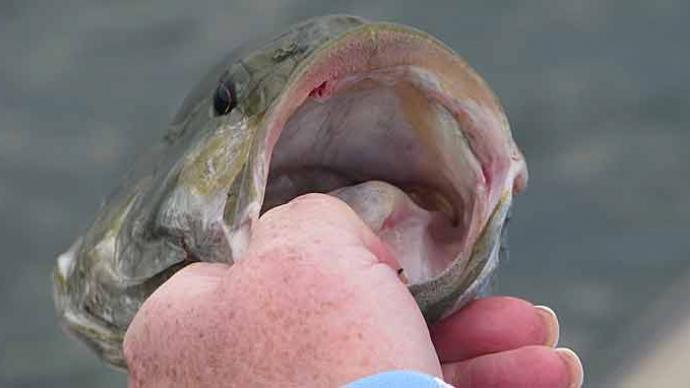
In the late 1980s and early 1990s, bass tournament anglers, such as Missouri’s Guido Hibdon and Florida’s Shaw Grigsby, opened the fishing world’s eyes to sight fishing for spawning bass. They did it with spinning rods, light lines, and small soft-plastic lures, especially tube baits, even targeting big bass in heavy cover.
Fast forward about a decade, and bass anglers stepped up their bed-fishing game. Not only were they becoming more proficient thanks to a better understanding of spawning bass behavior, but more reached for stout tackle — baitcasting outfits, heavy line, and bulky Texas-rigged soft-plastic lures such as creature baits. While this bed-fishing approach remains popular with many bass anglers, others are adopting a new generation of finesse presentations to the tactic.
Today’s finesse rigs for spawning bass are improved over the past years. They remain subtle but bring more efficiency and life-like action. That encourages more bass to bite, regardless of their mood. Of particular interest are the drop shot and Neko rigs. The first is often deployed in deep water, especially where smallmouth congregate in summertime. But its ability to present small soft-plastic lures in one spot, distant from a weight, makes it appealing to anglers chasing wary bedding bass.
The Neko rig takes shape when a nail-shaped weight is inserted into the thicker end of a finesse or stick worm that’s rigged wacky style. “It’s always something you need to have ready,” said Micah Frazier, who won the 2019 Bassmaster Elite Series’ St. Lawrence River event and has qualified for four Bassmaster Classics.
Little movement, lots of action
Sight fishing for bedding bass requires pinpoint presentations. Simply putting your lure into a bass’ bed often isn’t enough to generate a strike. It needs to settle on the “sweet spot,” the precise place within a spawning bed that bass are most interested in defending. Miss it by a few inches, and the bass may swim right by your offering. But land a direct hit, and it’s game on.

A drop shot lets you put your soft-plastic lure on that sweet spot while sequestering the weight outside the bed. Start your approach with a pitch or cast. Either work, but both need to go over the sweet spot. Finding the best one may take a few attempts from different angles.
After your weight hits bottom, slowly pull the rig toward you, stopping once the lure is precisely where you want it. With the line draped over the bed, you can gently shake your rod tip, agitating your lure above the sweet spot. And when you stop shaking, your lure falls into the nest.
Finding springtime bass takes a speedy and far-reaching approach, which Frazier undertakes with a 5-inch, YUM Dinger. He rigs the stick worm wacky and without a weight. He can skip it around shallow cover, grabbing the attention of wary bass cruising or bedding. But to catch more of the latter, he needs more weight. That’s where the Neko rig comes into play.
The Neko rig’s weight allows Frazier to fish faster. Instead of waiting for his weightless worm to settle into the strike zone, it goes directly to the bottom. If he doesn’t get a bite, he can retrieve it and send it to the next target, quickly covering the water. “That [efficiency is] really why I love it so much,” he said.
A Neko rig’s additional weight adds accuracy, allowing Frazier to drop it right on a bed’s sweet spot. “You can get it falling like a dart,” he said. Once there, the weight locks one of the ends of the worm to the bottom, allowing him to impart action into the tail. “With the nail rig, it stays better when you shake [your rod’s tip],” he said.
Widespread acceptance
Frazier only has to drive a couple of hours northeast of his Newnan, Georgia, home to arrive at what might be the best place to fish a Neko rig. “Lake Hartwell is the Neko capital of the world,” he said. Bass have ample opportunity to bite the subtle offering because of the deep clear water, a scenario that also is home to a drop shot. “That’s where it shines,” he said.
Frazier seeks out likely spawning targets for his Neko rig, which he fishes in water no deeper than 2 feet 95% of the time. They could be light or dark spots on the bottom of protected pockets, a lone rock, sunken brush, or a boat-dock post. The Neko rig’s extra weight also generates longer casts, allowing him to stay farther away and go undetected in clear water.
Once his Neko rig reaches a bed, or where he believes a bass is, Frazier doesn’t leave it there for long. He’ll give it a few shakes before retrieving it. He never fishes it back to the boat. He said the bite happens quickly if a bedding bass is there. But even if one doesn’t come, he doesn’t drop it. “I still have the confidence to keep fishing it,” he said.
Frazier said the Neko rig isn’t a one-trick pony. He’ll fish it for bass bedding in water as deep as 10 or 15 feet or around boat docks floating over 30 to 40 feet of water. “It’s limitless,” he said. “I use it a lot on most lakes,” he said. “It’s something I always have on deck.”
Frazier also bumps up the weight in his Neko rig and fishes it vertically for suspended bass or on the bottom in deep water. It takes more effort, patience, and a good understanding of how to read electronics than fishing it shallow, but it can be as productive. “I do that a lot,” he said.

Heavy cover and big bass are the only exceptions to where Frazier will fish a Neko rig during the spawn. When facing either, you’re better off trying to catch them on something else, he said. Texas’ Lake Fork is a prime example. He said only baitcasting gear, heavy line, and stout hooks can stand up to its world-class bass and gnarly flooded timber. You’ll only run into problems if you don’t.
Careful assembly required
Frazier doesn’t use much weight in his Neko rig, only a Swagger Tackle 1/32 tungsten nail weight. “That’s not a lot of weight,” he said. Its ridges keep it securely at the end of bait while casting or skipping.
A No. 2 Gamakatsu G Finesse drop-shot hook is what Frazier chooses for his Neko rig about 90% of the time. It’s compact, which helps his bait’s action, and its wide gap ensures better hookups. The other 10% of the time, when he’s throwing the rig into heavier cover, such as flooded bushes or laydowns, he uses a hook that sports a weed guard.
Frazier runs the hook under an O-ring placed near the Dinger’s midsection. It makes them last longer; without it, the impact from skipping across the surface or bites from bass can cause the hook to tear through the plastic, making the bait useless.
Frazier keeps his color choices simple. He said 99% of the time, he’s fishing a worm that’s either green pumpkin or watermelon with flake, usually red. “Some lakes they like [watermelon] better,” he said. He lets the bass make the choice.
Frazier throws his Neko rig on a 7-foot Abu Garcia Fantasista spinning rod that sports a medium action. He matches it with an Abu Garcia MGXtreme spinning reel. The amount of cover dictates which line he uses. If it’s thin, his main line will be 12-pound test Sunline braid with a few feet of 7-pound test Sunline fluorocarbon as a leader. He steps up to an 8- or 10-pound test leader when the cover is thicker.
While a braid-fluorocarbon combination works well under most conditions for a drop shot, it can be a hindrance when fishing for bass spawning among matted or emergent vegetation or brush. The knot — Alberto, double uni, or FG — can catch on or tangle in that cover, ruining your presentation. In those cases, it’s best to use straight fluorocarbon, eliminating the knot.
Drop shots require a slow-action rod. Fast action rods move the line instead of shaking it. A slower action rod, often squeezing and releasing the handle, puts enough action into the lure. Choose soft-plastic lures with straight or flat tails for the most action because curl tails require forward movement to work. Tie your weight at least 18 inches below the hook, farther if the water is clear and the bass are extra spooky.
In this situation, you’re better off Texas rigging your soft-plastic lure on a drop shot. An exposed nose hook may accidentally catch a semi-interested bass outside the mouth before it strikes, and those catches don’t count in most tournaments. Texas rigging keeps the point protected until you’re sure it’s time to set the hook.
The adage of going with as light a weight as needed applies here, too. Smaller weights make soft splashes that bass are less likely to detect. You want one just heavy enough to ensure pitching or casting accuracy.
BassResource may receive a portion of revenues if you make a purchase using a link above.




